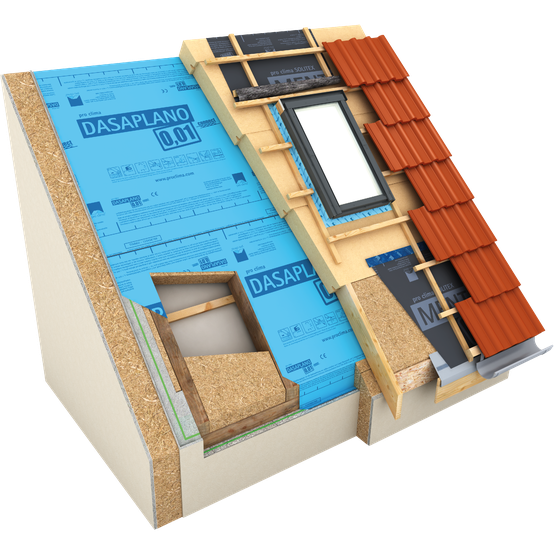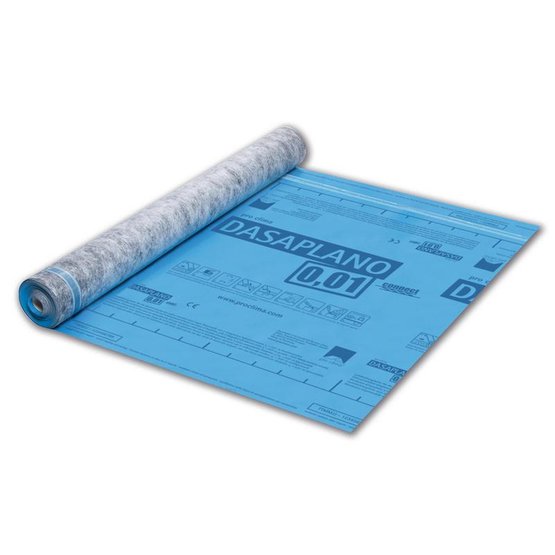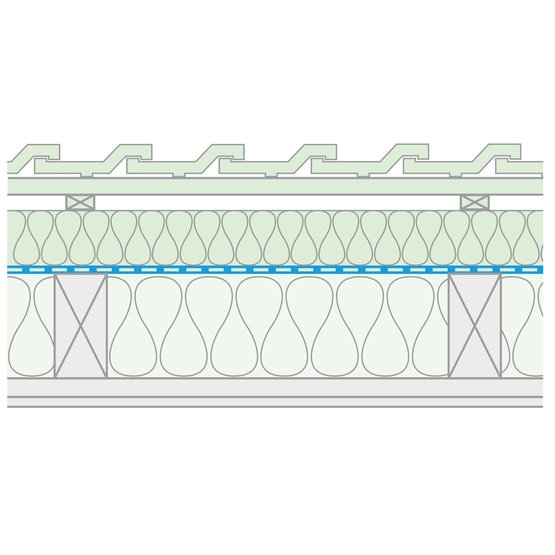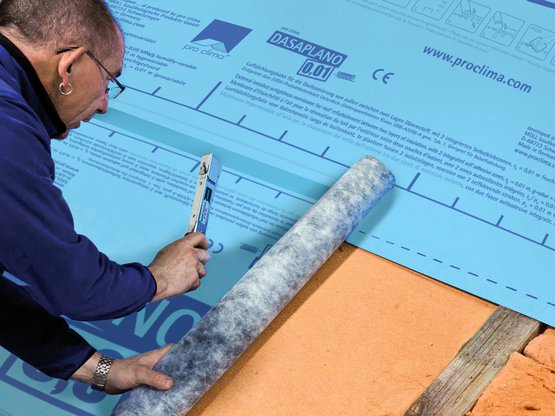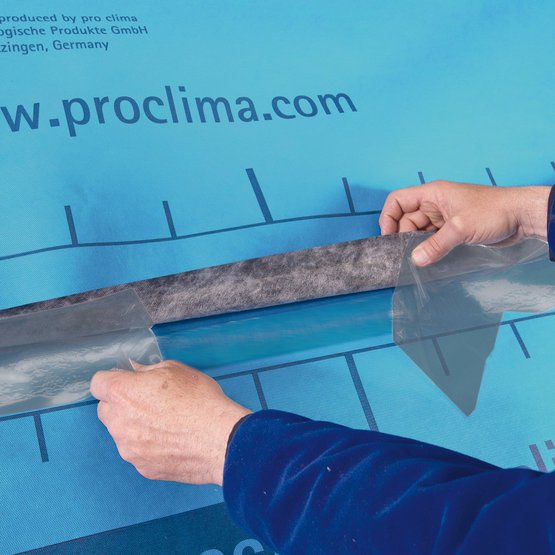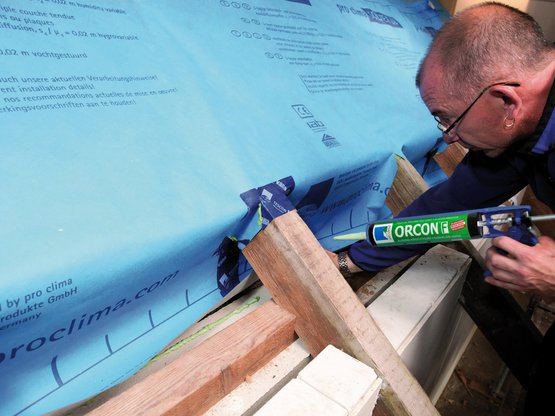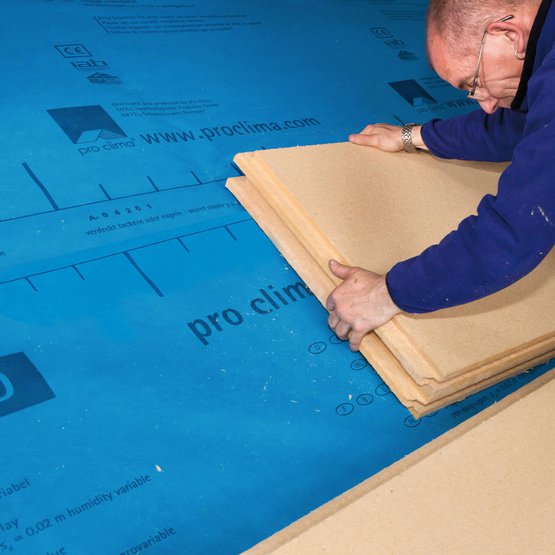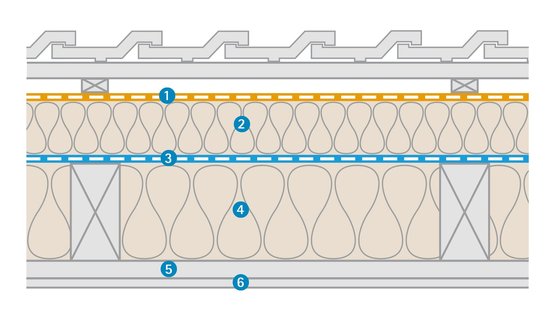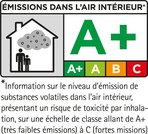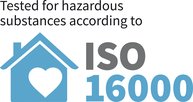Airtightness membrane for roof refurbishment from the outside, with self-adhesive strips
Advantages
- Simple implementation of the airtightness layer: installation across rafters and insulation
- Dry and well-protected building structures thanks to active moisture transport
- Protection during the construction phase: suitable as a temporary covering
- Quick and reliable adhesion thanks to the integrated ‘connect’ self-adhesive strips along the membrane strips
- Excellent values in hazardous substance testing, has been tested according to the ISO 16000 evaluation scheme
Areas of application
For use as an airtightness membrane that can be subjected to outdoor exposure for roof refurbishment from the outside in the case of full packing of the existing spaces between the rafters with insulation. Installation across the rafters, underneath an additional layer of over-rafter insulation consisting of wood-fibre underlay panels. Please contact Technical Support at pro clima in Germany for assistance with calculating the thickness of the external wood-fibre insulation that is required from a building physics viewpoint.
Planning and construction guidelines
Areas of application
DASAPLANO 0,01 connect can be used on roof refurbishment projects to improve the energy efficiency of residential buildings and buildings with residential-like use in order to achieve the airtightness necessary to ensure that thermal insulation can do its job properly and reliably.
The airtightness of existing buildings is generally not good enough to meet current requirements. DASAPLANO membranes prevent humid, warm air from indoor spaces from entering into the insulation structure, thus protecting these structures against condensation formation that can lead to moisture damage.
The airtightness of this membrane has been tested in accordance with EN 12114, and thus fulfils the requirements of the DIN 4108-7, SIA 180, RE 2020 and of the current version of the German Energy Saving Ordinance (GEG).
For installation across the rafters, underneath an additional layer of over-rafter insulation consisting of wood-fibre underlay panels; please contact Technical Support at pro clima in Germany for assistance with calculating the thickness of the external wood-fibre insulation that is required from a building physics viewpoint.
Refurbishment solution:
Between-rafter insulation consisting of fibrous insulation material. Insulation covering with wood-fibre underlay panels.
- Optional roofing underlay, e.g. SOLITEX MENTO 3000
- Over-rafter insulation, wood-fibre underlay panel
- DASAPLANO 0,01 connect
- Insulation between rafters, fibrous
- Service cavity, if necessary
- Inner cladding: gypsum plasterboard or plaster on lightweight wood-wool boards
The thickness of the external wood-fibre insulation needs to be calculated on a project-specific basis. Please contact Technical Support at pro clima in Germany for assistance.
Can be used as a temporary covering
When DASAPLANO 0,01 is installed as an airtight membrane on roof refurbishment projects, it can be subjected to outdoor exposure for up to 14 days to serve as a temporary covering. The outdoor exposure period is reduced in this application case because the membrane also acts as an airtightness layer and regulates moisture here, alongside its function as protection for the structure during the construction phase.
If the structure is exposed to the elements for a longer period during the cold season while the necessary external roof insulation is not in place, increased condensation formation can occur. The roof pitch must not be less than 14° (3:12) and/or the minimum roof pitch for the wood fibreboards.
The specifications of the applicable national regulations are to be taken into account when carrying out installation and taping/adhesion. Additional mechanical fastening must be carried out if the membranes are used as temporary coverings.
If nail-sealing is required during the construction phase, TESCON NAIDECK mono can be used. This tape is applied to the support battens.
Dark marks may form on the membrane as a result of rainwater. These have no influence on the high level of watertightness or the effectiveness of the interior membrane layer.
Note
Maximum of 7 days of outdoor exposure for average daily temperatures below 10 °C (50 °F).
Increased indoor humidity
The high indoor humidities typically present in bathrooms and kitchens are unproblematic with this membrane. DASAPLANO 0,01 connect can be installed on construction sites where no significant plastering or screed work is being carried out.
Quality assurance
In the case of membrane installation on the outside, efficient quality assurance can be carried out during the course of construction by means of differential pressure testing with overpressure and artificial fog. As part of this testing, fog is generated inside the building using a fog machine. In this way, the airtightness of detail features can be checked and rectified on the exterior.
The membranes must be mechanically secured to a sufficient extent beforehand. For this reason, taped and adhesive joints are to be implemented with particular care.
Detailed construction planning – particularly of joints at the eaves and gable ends and the implementation of these joints on roof refurbishment projects – is particularly important.
In Germany, this quality assurance during the course of construction is no substitute for final testing of airtightness in accordance with the German Building Energy Act (GebäudeEnergieGesetz, GEG) or the requirements of the German Reconstruction Loan Corporation (KfW) regarding the determination of the air change rate (n50 value).
Technical support
If you have questions relating to planning and installation, please contact pro clima Technical Support.


